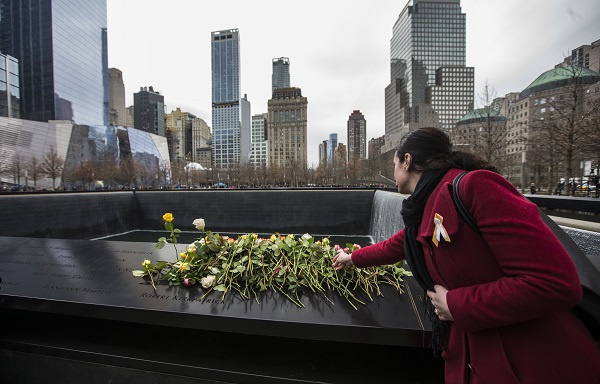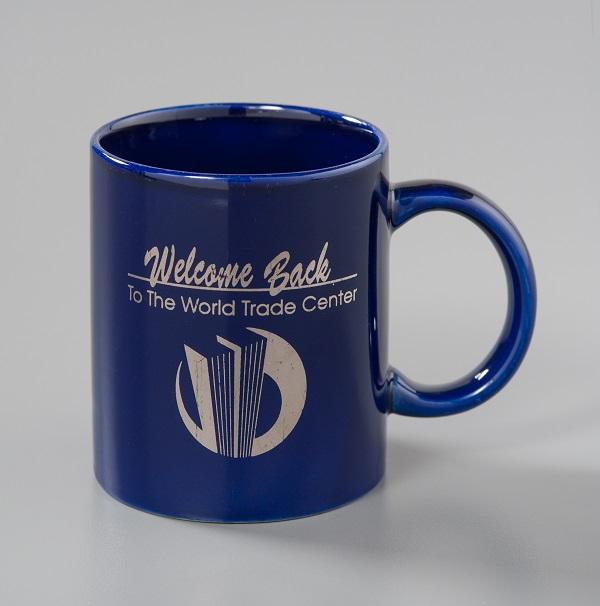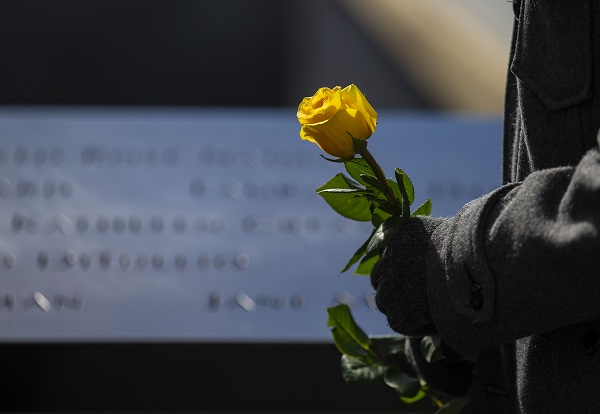Ceramic mugs branded with promotional messages and corporate logos have been office kitchen mainstays for decades. Their sturdy design and glazing keep beverages hot and well contained, aiding the morning ritual of coffee or tea at a desk or around a conference table.
In the wake of the February 26, 1993 World Trade Center bombing, the 50,000 evacuees from the complex had experienced not only inconvenience but also strain and fright, especially those obliged to maneuver down unlit stairwells filled with dense smoke. The blast had killed six people. Hundreds more were injured. As landlord, the Port Authority offered anxious returning tenants free pastries, a coupon book for use in the WTC’s shopping concourse and a blue coffee mug decorated with the agency’s logo (depicting the Twin Towers). It bore the upbeat silver-luster inscription: “Welcome Back to the World Trade Center.”
Ten identical 1993 souvenir mugs now reside in the Museum’s collection. Wouldn’t one suffice to represent the historical event that triggered their customized production and give-away? Are artifact redundancies desired or informative? In the case of the historical continuum we narrate, with human experience at its core, “more” can be more revealing. Although uniform in size, appearance and date, each mug connects to a nuanced, individualized story hinged by the operations of fate.
For instance, the mug donated by Irving Lief, employed by Dai-Ichi Kangyo Bank in the North Tower, has the benefit of its original contents—not coffee but a printed note curled inside reading, “Welcome Back to the World Trade Center. Thank you for your spirit, support and cooperation. It’s made getting back to business a lot easier for all of us at the World Trade Center Community.” It bears the signatures of Stanley Brezenoff, executive director of the PANYNJ at the time of the 1993 attack, and Charles Maikish, director of the WTC.
North Tower tenant and public information officer in media relations for the Port Authority Terry Benczik also responded to the February 26 emergency. She initially left the building with her colleagues, exiting from the 64th floor. Within hours she was engaged in the agency’s crisis communications and efforts to explain the scope and cause of this unprecedented attack. For Benczik, the logo stamped on the mugs presented to returning tower occupants was a source of pride as well as a pledge that their comfort and security were of prime concern, with upgrades underway to insure both objectives.
In the South Tower, interpretations varied about the source of the loud boom intruding into lunch hour on that snowy Friday. Morgan Stanley employee Paul Devito, on the 44th floor, assumed that a transformer had erupted in the basement. Other speculations focused on a derailed PATH train or a vehicle collision outside. When smoke began infiltrating the offices, Devito and many of his coworkers grabbed coats and essentials, heading for the street. With elevator service frozen, they had no choice but to descend on foot, weathering congested stairwells that were also dark and permeated with fumes. The internal evacuation of the South Tower lasted all day and into the night.
Jim Kazalis, another Morgan Stanley tenant, experienced this same uncomfortable ordeal. He noted later that those who sheltered in place, plugging doors with toweling to block the smoke, “fared better than those who left immediately.” (Unfortunately, eight years later, that memory conditioned decisions made by individual 1993 survivors about escaping the building that Tuesday morning, delays proving fatal to many.) As a firm, Morgan Stanley recognized the ongoing threat of terrorism at the Twin Towers, implementing rigorous post-1993 bombing safety and evacuation protocols, with full employee compliance mandated. The mugs issued to Devito and Kazalis welcomed them back to familiar surroundings albeit an address facing a sobering new reality.
Credit lines associated with several other mugs forecast what lay ahead for their receivers. After the truck bomb devastated the North Tower’s basement parking garage, Walter (Wally) Travers labored for five hours to descend the stairs from his 104th floor brokerage office at Cantor Fitzgerald. When he finally reached home in New Jersey, he told his wife that visibility in the stairwells was so poor that he and his fellow evacuees had formed a human chain, resting their hands on each other’s shoulders to guide themselves down and out. His white dress shirt—worn to work that same morning—was soiled with soot above his belt-line. When terrorists struck again on September 11, hijacked Flight 11 fatally trapped Travers and 657 others present at Cantor Fitzgerald as of 8:46 a.m. Travers’ wife later found the unlaundered shirt in a closet along with the “Welcome Back” mug commemorating Wally’s recall to the revamped hi-rise in spring 1993. She gave them to the Museum in his memory, and as portents of the escape denied him on 9/11.
Another “Welcome Back” mug was included in a group of items paying tribute to the life and career of Douglas Karpiloff, director of security and life safety operations at the WTC, donated by his widow. After the 1993 attack, he helped develop and implement numerous security innovations at the landmark Port Authority–run property. These included new photo identification cards issued to agency personnel, tenants, contractors and guests authorized to access the premises. Badge registration, in other words, was another aspect of the “Welcome Back” roll-outs instituted to tighten physical control over the complex. Safeguards like this inhibited the threat of danger being driven or walked into the towers. Unfortunately, they proved futile against an airborne weapon flown into them. On September 11, Karpiloff was killed while engaged in directing the civilian evacuation of the buildings.
Our survey of “Welcome Back” mugs are not reduplications of the same story. As conveyed through their individual donor provenance, each offers a differing prism into the first terrorist strike on the WTC, its repercussions and relevance to the deadlier, culminating attack of September 11, 2001.
By Jan Ramirez, Executive Vice President of Collections & Chief Curator, 9/11 Memorial Museum


